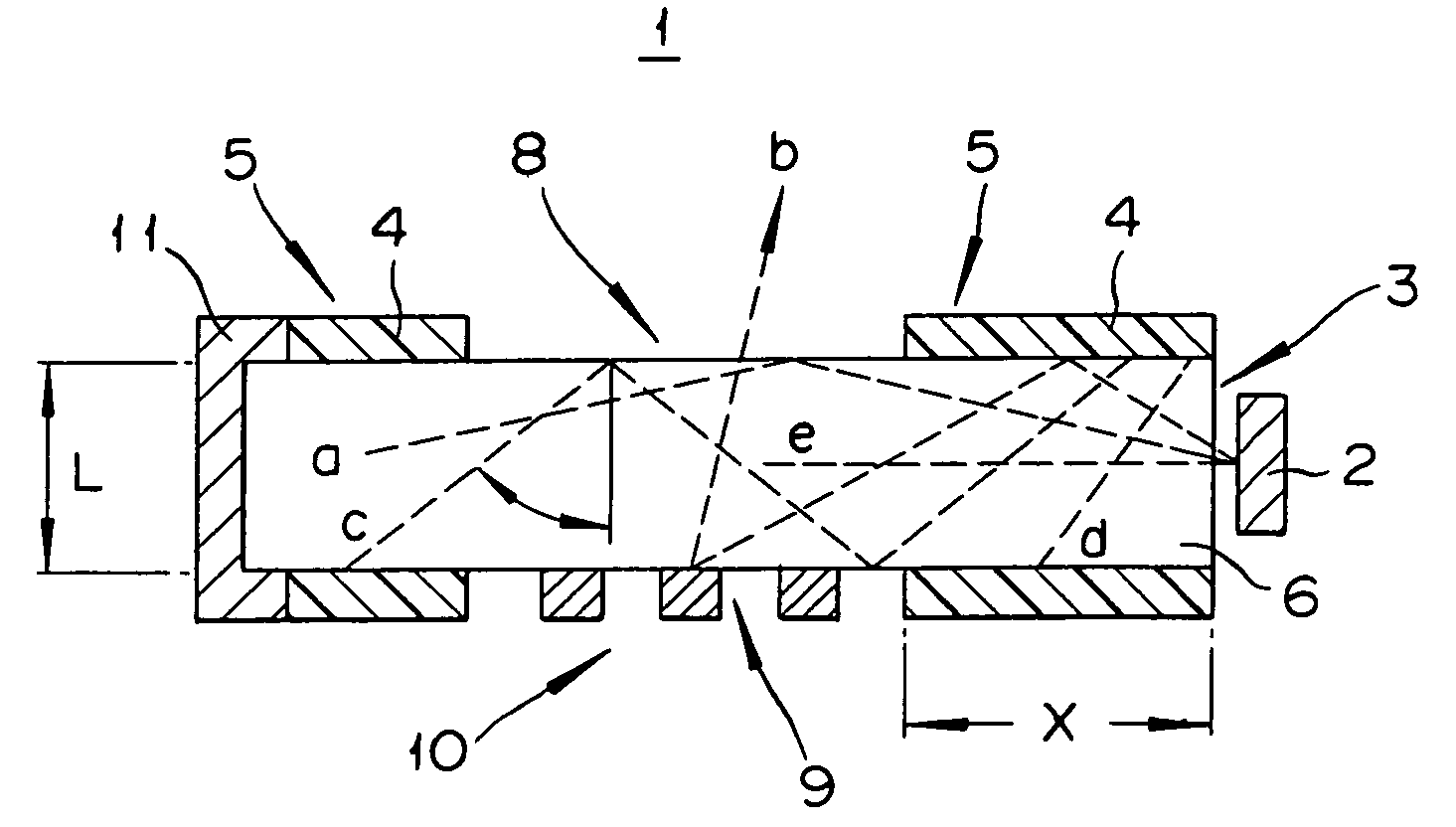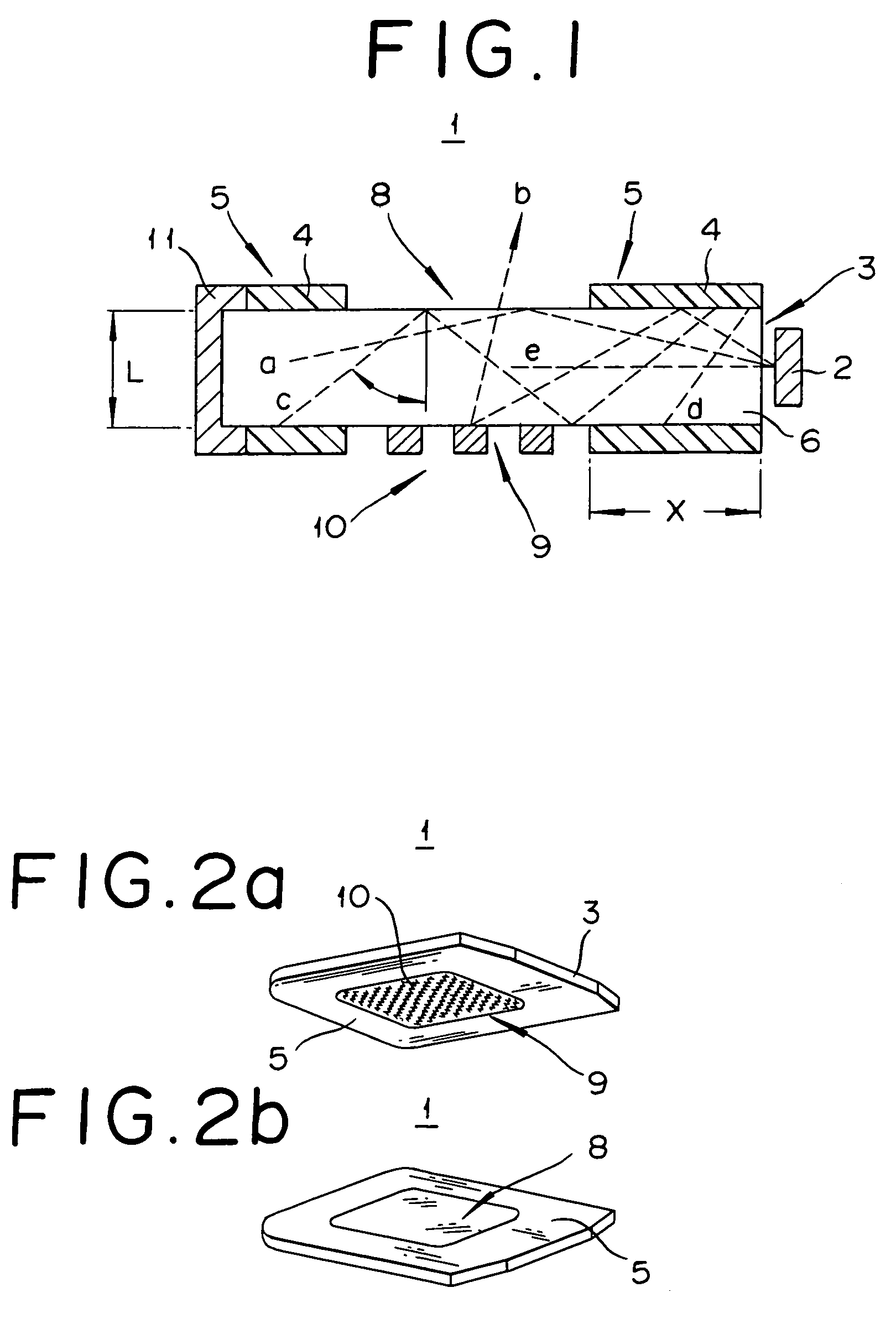Light waveguide and fluorescent sensor using the light waveguide
a light waveguide and fluorescent sensor technology, applied in the field of light waveguides and fluorescent sensors using light waveguides, can solve the problems of complex configuration of fluorescent spectrophotometers, inability to reduce to such a size, and small fluorescent signal obtained, so as to achieve efficient guided and efficient excitation to the photodetector
- Summary
- Abstract
- Description
- Claims
- Application Information
AI Technical Summary
Benefits of technology
Problems solved by technology
Method used
Image
Examples
example 1
[0130]Example 1 pertains to a light waveguide 1 using a synthetic quartz plate (0.7 mm thick, 20 mm wide, 30 mm long; refractive index: 1.46; produced by Asahi Glass Co., Ltd.) as a waveguide main body 6.
[0131]In producing the light waveguide, first, a PET-based masking tape was adhered to one side of the synthetic quartz glass, and the masking tape was perforated. The holes were opened in the PET surface at a position spaced by at least 5 mm from an end portion of the synthetic quartz plate and in a 10 mm×10 mm region by use of an excimer laser. The holes had a diameter of 0.2 mm. The number of the holes opened in the 10 mm×10 mm region was 95, with a hole center interval of 1 mm.
[0132]In this case, masking may be conducted by use of a urethane resin dope or a styrene-based resin dope in place of the PET-based making tape, and only the resin portion may be similarly perforated by the excimer laser. Besides, the hole diameter can be controlled within the range of from 1 μm by regula...
example 2
[0142]Example 2 pertains to a light waveguide produced by use of a borosilicate glass plate (produced by Schott Corporation) having the same dimensions as those of the synthetic quartz plate shown in Example 1 as the waveguide main body 6.
[0143]In producing the light waveguide, first, excimer laser (KrF; 280 mJ, 80 shots, 100 Hz) was radiated directly to the borosilicate glass plate, to produce holes with a hole diameter of 300 μm in the same pattern as in Example 1. The holes constitute recessed portions 61, the depth of which was 30 through 40 μm.
[0144]Subsequently, aluminum was sputtered by the same process as in Example 1, to produce an irregular reflection portion 10 with a diameter of 400 μm. The coverage of the light transmitting surface 9 with aluminum was 12%.
[0145]In Example 2, also, like in Example 1, the scattering of the wave-guided light from the whole area of the recessed portions 61 in the irregular reflection portion 10 could be recognized through the light radiatin...
example 3
[0146]Example 3 pertains to a fluorescent sensor 110 having a single window portion 112, produced by use of the light waveguide 1 produced in Example 2.
[0147]First, a light source 2 was disposed at a predetermined position in a housing 111, and was connected to the light waveguide 1. To obtain the light source 2, a 5 mmφ shot-type LED (produced by Sander Electronic Co., Ltd.) was machined so as to facilitate connection thereof to a side face of the waveguide, was adhered to a predetermined position in the housing by use of a commercially available black adhesive, and was connected to the light waveguide 1. In addition, a commercially available precision measurement photodiode (produced by Hamamatsu Photonics K.K.) with a 10 mm×10 mm measurement surface was connected to the absorption layer 4 in the periphery of the light transmitting surface of the light waveguide 1, with a commercially available optical filter (SC42; produced by Fuji Photo Film Co., Ltd.) therebetween, by use of a ...
PUM
| Property | Measurement | Unit |
|---|---|---|
| depth | aaaaa | aaaaa |
| diameter | aaaaa | aaaaa |
| diameter | aaaaa | aaaaa |
Abstract
Description
Claims
Application Information
 Login to View More
Login to View More - R&D
- Intellectual Property
- Life Sciences
- Materials
- Tech Scout
- Unparalleled Data Quality
- Higher Quality Content
- 60% Fewer Hallucinations
Browse by: Latest US Patents, China's latest patents, Technical Efficacy Thesaurus, Application Domain, Technology Topic, Popular Technical Reports.
© 2025 PatSnap. All rights reserved.Legal|Privacy policy|Modern Slavery Act Transparency Statement|Sitemap|About US| Contact US: help@patsnap.com



